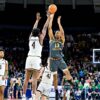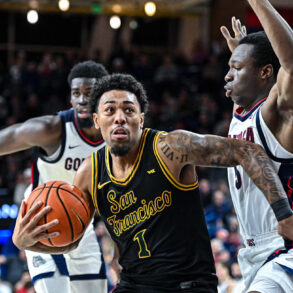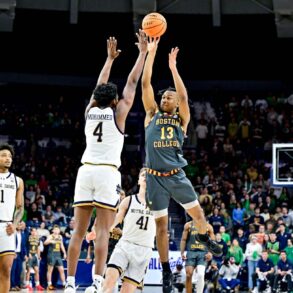More than 1,500 Division I women’s basketball players entered the portal this season, including nearly 300 power conference players — that’s an average of four players per power conference team.
With most of the top transfers finding their landing spots, it’s time to look again at the landscape of the sport. The best players in the portal had a chance to improve their future team’s ceilings, locate a better spot for themselves or receive more NIL money. But from a basketball perspective alone, some of these fits — especially those who seem to be the perfect puzzle piece on some national title and conference title contending teams — were just … chef’s kiss.
Advertisement
Let’s examine five players (in alphabetical order) who seem to be perfect fits at their new programs:
MiLaysia Fulwiley, LSU
2024-25 stats (at South Carolina): 11.7 PPG, 2.8 RPG, 2.0 APG, 1.5 SPG (19 minutes per game); 43 percent FG, 26 percent 3-point FG
Fulwiley’s transfer to LSU makes an already great SEC rivalry that much spicier (Thank you, basketball gods). This fit is pretty dang appealing for other reasons as well. The duo of Flau’jae Johnson and Mikaylah Williams gave the Tigers a high-octane playmaking backcourt. Adding Fulwiley? Yeesh. Talk about showtime in Baton Rouge.
Transition time has slowly ticked upward in Kim Mulkey’s four seasons at LSU. Last season, the Tigers spent nearly a quarter of their possessions in transition, and with the addition of Fulwiley to the Johnson-Williams backcourt, I’m assuming that number will go even higher. All three players can create or score in transition, and adding Kate Koval (Notre Dame) as a center who is ready to run the floor gives them a dump-off option in the paint, too. It’s a role that Fulwiley, in her limited minutes, played well at South Carolina, as 45 percent of her scoring and 39 percent of her assists came in transition.
Advertisement
Fulwiley also gives the Tigers versatility in their pick-and-roll game. They often used high screening actions last season with Aneesah Morrow at the four. If LSU goes small and runs Jada Richard at the point, bumping Fulwiley-Johnson-Williams to the two through four, then Williams becomes the player setting high-ball screens. Though she doesn’t have the same inside presence as Morrow, her ability to step out and knock down 3s makes this pick-and-roll option with ballhandlers like Fulwiley or Johnson a fun two-player game. Last season, Williams acted as a ball screener only four times, including twice when she hit 3-pointers. So, LSU can see how this new wrinkle changes its offensive schemes, considering pick-and-rolls and spot-ups were the Tigers’ most common possessions in half-court play. With Fulwiley as the ballhandler (and ability to score at all three levels, including — like below — in the midrange) and Williams as the screener (and Johnson off-ball), defenses will be forced into a true pick-your-poison.
Gianna Kneepkens, UCLA
2024-25 stats (at Utah): 19.3 PPG, 5.0 RPG, 3.0 APG (30 minutes per game); 50.4 percent FG, 44.8 percent 3-point FG
At Utah — both under Lynne Roberts (who departed early last season for the vacant L.A. Sparks job) and current coach Gavin Petersen — Kneepkens played in a unique offense that basically ignored the midrange. In fact, Kneepkens has attempted exactly 89 midrange jumpers in her career (roughly eight percent of her total shots). UCLA doesn’t skew quite this extreme, but it isn’t exactly a midrange-loving team — only 12 percent of its field goal attempts were midrange shots last season.
Advertisement
Timea Gardiner was last season’s most efficient 3-point shooter, knocking down nearly 40 percent of her attempts, but Kneepkens’ 45 percent 3-point shooting (with a 63 percent effective field goal percentage) will give UCLA’s offense a secondary counterweight to Lauren Betts in the post, which should benefit both players. Kneepkens is better than almost anyone in the nation on either wing or in the left corner, which will allow the Bruins to set her up to force defenses to shade more to her. That also will open driving lanes for Kiki Rice and provide more space in the paint for Betts. More than one-third of her 3-pointers last season came from catch-and-shoot scenarios, off which she shot 48 percent, mostly because of her quick release.
Because defenses had to respect her elite 3-point shooting, Utah also loved running Kneepkens off high screens. If defenders went under, she could step back and knock down a triple, but she also has the size and ballhandling to attack the basket. (Most of her limited midrange shots also came in these scenarios when she decided to stop and pop.)
UCLA fans should be thrilled (and opponents terrified) about the potential of a Kneepkens-Betts two-player game. UCLA didn’t need to expand Betts’ game outside of the paint, but Bruins coaches say the midrange game is in her wheelhouse. If coach Cori Close can put one of the nation’s best 3-point shooters and the nation’s best center (with an extended range) into some high two-player situations, it’s dangerous. Betts has better size and hands than anyone Kneepkens has played with thus far. Then, consider Rice or Gabriela Jaquez off ball and ready to slash, or Gardiner standing by in the left deep corner (where she shot 44 percent from beyond the arc). I’m scratching my head trying to figure out how opponents will stop this. Let them cook, Cori!
Oluchi Okananwa, Maryland
2024-25 stats (at Duke): 10.1 PPG, 5.3 RPG, 1.8 APG, 1.8 SPG (22 minutes per game); 47.3 percent FG, 30 percent 3-point FG
Advertisement
Most players on this list joined more fully-formed teams, but Maryland reloaded almost entirely from the portal once again to replace losses of Shyanne Sellers, Sarah Te Biasu and Christina Dalce to graduation or the WNBA.
Okananwa makes it onto this list because coach Brenda Frese has perfected the art of adding multiple key transfers and continuing to chug along. Even with the additions of Yarden Garzon and Gracie Merkle (who both will likely play large roles), Frese can quickly get these transfers to mesh with the returners and one another fairly quickly.
To best understand the impact Okananwa can have, look no further than her three-game stretch during Duke’s ACC tournament title run last season. She averaged 16 points, seven rebounds and two assists per game while shooting 65 percent, including a blistering 6 of 8 from beyond the arc.
Unlocking Okananwa’s offensive potential and giving her a bit more pace to play with is a recipe for expanding her game and getting the Terrapins back into the top third of the Big Ten after losing so much following a Sweet 16 run.
Advertisement
I’m particularly excited to see Okananwa as Maryland’s best perimeter defender. The Terrapins aren’t exactly known for stout defense (Frese would much rather just outscore opponents), but Okananwa best fits into Maryland’s identity because of her steal-and-score or steal-and-create abilities. Getting out in transition with Smikle and Garzon provides Maryland a fun transition game. Last season, the Terrapins were one of the Big Ten’s best transition teams, shooting 51 percent and scoring nearly a quarter of their points there. Her defensive quickness and understanding of correct defensive positioning should steal a few possessions every game for Maryland.
Madina Okot, South Carolina
2024-25 stats (at Mississippi State): 11.3 PPG, 9.3 RPG, 1.1 BPG (23 minutes per game); 65 percent FG
The Gamecocks added two impressive players — Okot and Ta’Niya Latson — through the portal. As a go-to scorer and proven ballhandler, Latson’s addition is exciting, but I love the prospect of 6-foot-6 Okot elevating South Carolina’s chances to win a national title.
Advertisement
The Gamecocks’ interior defense last season didn’t quite meet the standard of the previous few seasons, and some of that can be chalked up to uber-athletic Ashlyn Watkins missing most of the season with an ACL tear. In her absence, Chloe Kitts and Sania Feagin did a nice job, but there was a noticeable difference from South Carolina’s typical fierce rim-protecting presence when Dawn Staley utilized Kamilla Cardoso and Aliyah Boston.
Okot is still a bit raw. Despite one season of eligibility remaining, she has played only one season of Division I hoops, after competing her first two seasons of college ball in Kenya. But she has the physical gifts and foundational tools for Staley’s staff to mold her into a polished, effective rim protector and interior presence who can clear space on the outside for shooters like Latson, Raven Johnson and Tessa Johnson to be as effective as they were during the 2023-24 season when Cardoso roamed the interior.
Offensively, Okot moves well and runs the floor nicely for someone of her size, and she’ll benefit from playing with multiple skilled, unselfish passers. On a team as deep as South Carolina, Okot won’t need to score 20 points per game, but she will need to make open shots.
I can’t wait to see how Staley’s crew uses Okot defensively. She’ll be facing some SEC posts for a second season, so she has the knowledge base of her opponents’ games, but the Gamecocks’ defensive scheme should free her to make even more plays at the rim. Already, she’s great at finding her assignment in transition and providing help (as seen below) while recovering to make big plays. Her size offers a change from 6-1 Kitts and 6-3 Joyce Edwards, but it’ll be fun to see how the Gamecocks can zero in on getting her into better initial defensive positioning and helping off the ball to create turnovers.
Serah Williams, UConn
2024-25 stats (at Wisconsin): 19.2 PPG, 9.8 RPG, 2.4 APG, 2.3 BPG (32 minutes per game); 49.3 percent FG
Advertisement
The national champs lost Paige Bueckers but return Azzi Fudd, Sarah Strong, Ashlynn Shade, KK Arnold … the list goes on. The Huskies also bring in freshman Blanca Quiñonez, a 6-2 Ecuadorian forward who has been playing professionally in Italy for the last four years. She might just be the front-runner for Freshman of the Year.
Adding a 6-4 former Big Ten Defensive Player of the Year who averaged a double-double last season is a case of the rich getting richer. Williams was perhaps the most sought after player in the portal, but she’s a perfect fit on both sides of the ball for the Huskies. She’ll bring a consistent inside presence that UConn lacked last season, while also allowing Strong to continue to roam all three levels offensively.
Williams spent about half her possessions posting up for Wisconsin last year, and even as the Badgers’ focal point, she was still super efficient, scoring 0.92 points per possession off each post up. (By comparison, Kiki Iriafen scored 0.97 points in each post up last season for USC.) Williams seals well and finds good positioning, even when she doesn’t get the ball on her first open look, and she’ll benefit from receiving crisper passes from better passers at UConn.
She also could be the Huskies’ best pure post defender in a minute, and their best rim protector/shot blocker since Olivia Nelson-Ododa. The Huskies were an exceptionally strong defensive team last season, but against top competition, they could’ve performed better by limiting paint scoring and keeping opponents off the offensive glass. (They were outrebounded on O-boards during the postseason.). Williams averaged more than seven defensive boards per game. She’ll be a much more disciplined, active player in the interior who can log heavy, physical minutes, which will alleviate some of the burden stemming from UConn posts’ foul troubles.
Advertisement
This article originally appeared in The Athletic.
Maryland Terrapins, UCLA Bruins, South Carolina Gamecocks, Connecticut Huskies, LSU Lady Tigers, Women’s College Basketball
2025 The Athletic Media Company
This post was originally published on this site be sure to check out more of their content.








